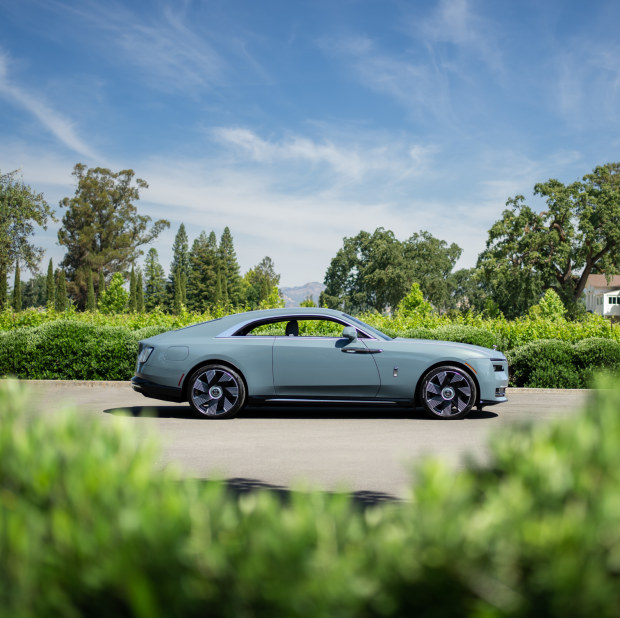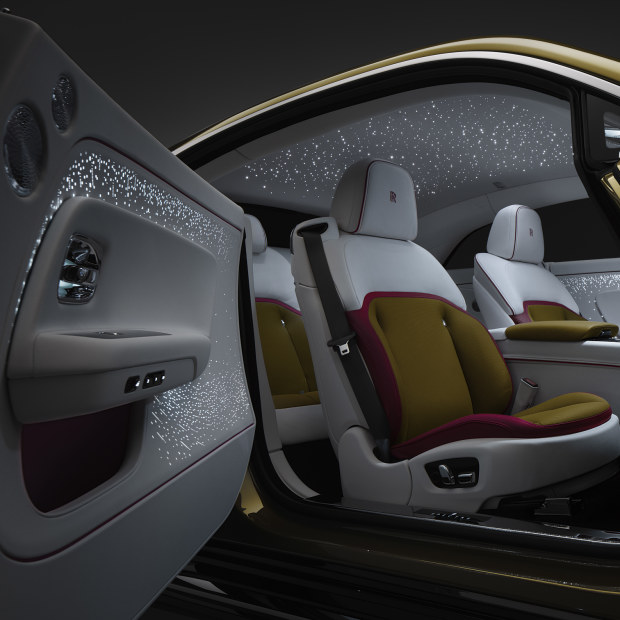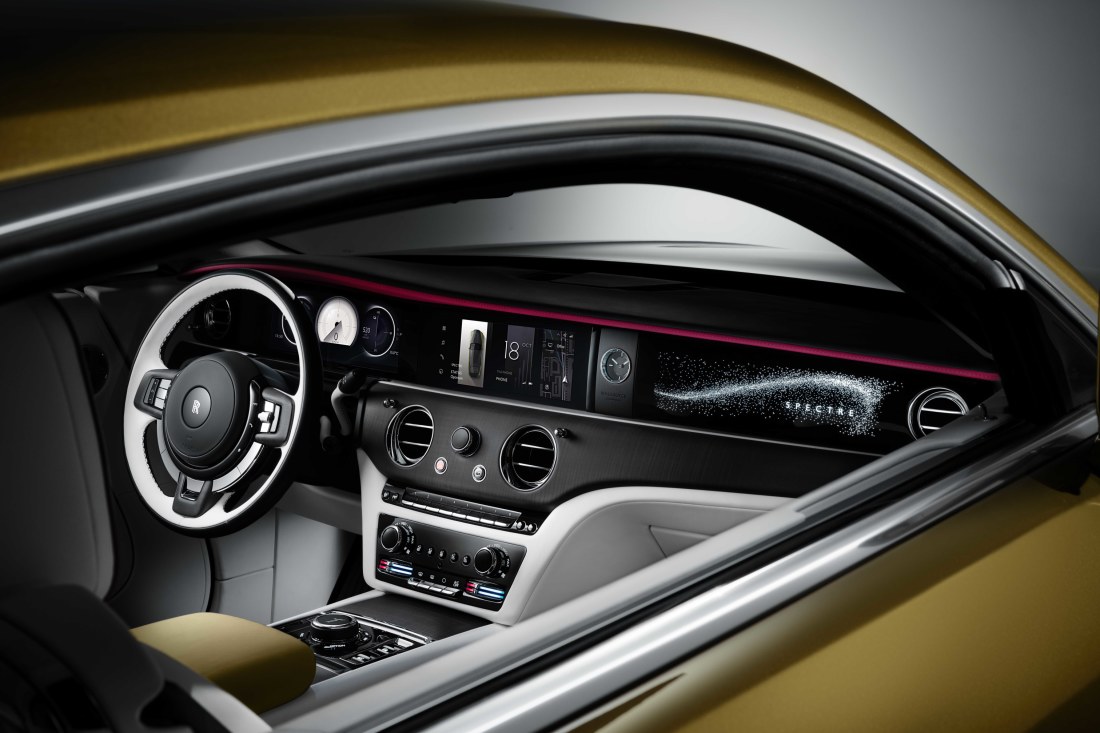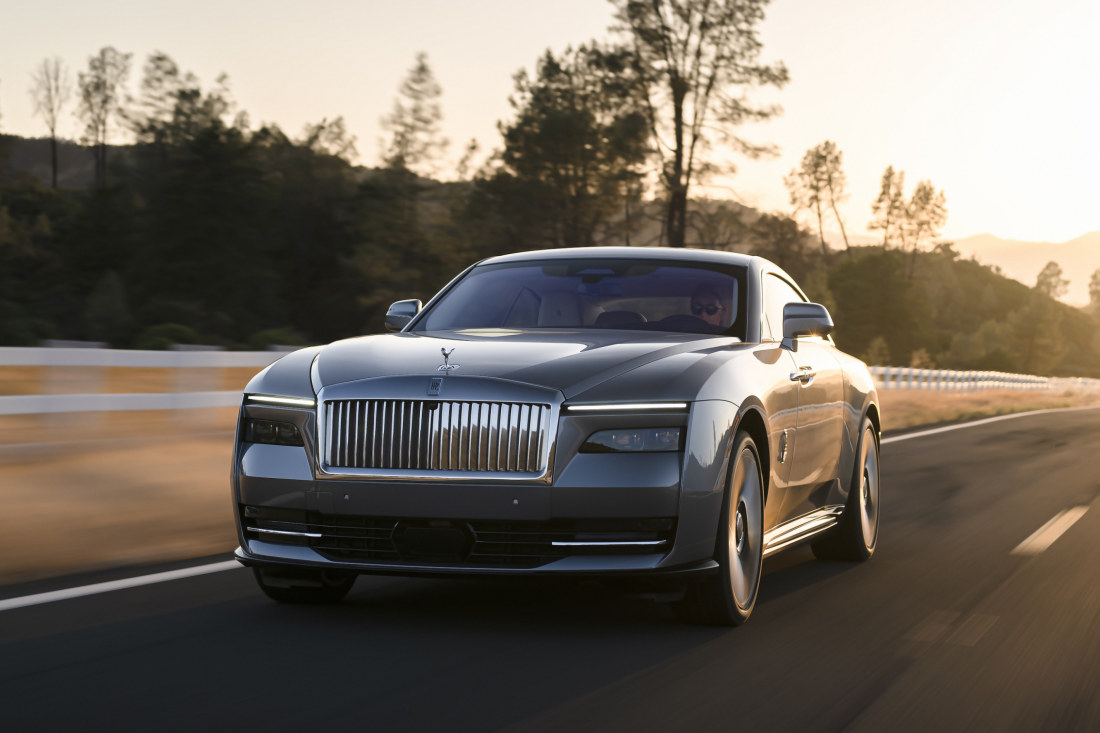The electric-vehicle market will hit a new high point in November when the Rolls-Royce Spectre reaches these shores.
The massive two-door pillarless coupe will cost $770,000, plus on-road costs, options and accessories. And, as almost every Australian-delivered Rolls-Royce receives upgrades and customising via the company’s Bespoke program, it is easy to imagine most examples costing closer to $1 million, drive away.
For that, buyers (or those who have undertaken commissions, as Rolls-Royce prefers to say) will receive a machine with far more presence than the photos show. The huge, 23-inch wheels deceive the eye, making the car look closer in proportions to the outgoing Wraith coupe. In fact, the Spectre is bigger in every dimension and much bolder in appearance. It is nearly 5.5 metres long, over two metres wide and weighs 2890 kilograms.
Head designer Anders Warming aimed for “sheer monolithic beauty”. He says the single-piece roof and rear haunches are made from the largest pressing in any car ever.

When asked why the car has a grille, which it doesn’t strictly need, and a long bonnet (ditto), he tells Life and Leisure: “I think we 100 per cent need our Pantheon grille, aesthetically, because that’s what informs the iconic impression of a Rolls-Royce. So a stainless-steel grille will remain, along with the ‘badge of honour’ and Spirit of Ecstasy mascot.”
The long bonnet was necessary when creating what was to be a Rolls-Royce first, and EV second, Warming explains. It also gave the head of engineering the opportunity for better rear headroom and weight distribution. “The V12 goes out, but he has space to position all his elements in the front, and that allowed us to lower the rear seating position [because] we don’t have extra pumps or any bits on top of the battery pack in the rear.”

The shape also makes for the slipperiest Rolls-Royce ever, a necessity to maximise range. The coefficient of drag is just 0.25, and the battery is a generous 102 kWh, though the official range of 530km between charges doesn’t set any records.
Fortunately for any owner with a very long journey to undertake, statistics show they typically have five or six other cars in the garage to choose from.
The Spectre is the opening salvo in a model renewal program that will take the entire Rolls-Royce fleet fully electric by the end of the decade. It’s easy to see why. Even though some traditionalists will bemoan the lack of the V12 engine still fitted in other current models, the silence, smoothness and unrivalled torque of an EV drivetrain is ideal for the company widely perceived as the pinnacle of luxury.
Furthermore, since Rolls-Royces are already so gargantuan, the inclusion of a battery pack doesn’t provide the proportional weight increase that afflicts smaller cars. The Spectre’s battery pack takes 34 minutes to charge from 10 to 80 per cent on a 195 kW fast charger.

Unsurprisingly, the Spectre sets new standards for refinement. With a couple of previous V12 models, the company claimed it needed to dial some of the noise back in because it was eerily quiet. No such effort here and the result is, yes, eery.
You can, however, press a “Rolls-Royce Sound” button, which synthesises various musical instruments and mechanical noises to give a science-fiction–like whirr under acceleration. It reveals itself only under acceleration; at cruising speeds the car is damn near silent, even with sound turned on.
The all-new interior is large, luxurious and customisable. The electronics and screens are unobtrusive and effective. There is leather everywhere; apparently owners are not calling for the new “vegan” materials fitted to many other EVs. The dozen or so cars on the international launch we attended, in Nappa Valley, California, were highly varied inside and out, with the designers making sure the vast range of exterior colour treatments (including bold two-tones) and interior hues and materials were on display.

There is no sunroof available, mainly to maximise headroom in the rear (it is a true four-seater, even tall adults will find plenty of room back there). Similarly, a glass roof was ruled out so that the Starlight Headlining could be offered. The “stars” – created by tiny fibre-optic lights – now extend to the interior door and rear quarter panels, with literally thousands of individual lights subtly illuminating the cabin if you tick the correct boxes on the option page.
The doors are simply enormous; again, at 1.5 metres long bigger than anything else in the Rolls world and probably in the car world too. They open and close under power, with sensors ensuring they move smoothly and consistently even when there are crosswinds or the car is parked on a steep angle.
The boot is large at 380 litres, though there is no storage in that long nose.
The ride quality is frankly better than anything I’ve experienced. The car seemed to glide above the varied surfaces of the Californian roads we were travelling on. If that sounds like a statement out of a brochure, apologies, but I’m not sure how else to put it, and the sensation is possibly exaggerated by the quietness. Either way, the level of isolation is supreme.
Handling is impressive too when the size and style of car are considered. That said, it’s not quite as sharp as the BMW i7 limousine. Rolls-Royce Motor Cars is part of the BMW Group and the Spectre and i7 share certain aspects, though are built on entirely different platforms. The Spectre has a unique aluminium space frame that has been adapted to all its models: the Cullinan SUV, Ghost sedan, Phantom limousine and now the Spectre two-door.

The big coupe goes where you point it with negligible lean, and great rapidity. The four-wheel drive and four-wheel steer helps, as does the low centre of gravity provided by having a 700kg battery in the floor. The Spectre has the biggest air springs ever fitted to a Rolls-Royce, plus the latest BMW-supplied, Rolls-honed chassis smarts. The regenerative braking works well. When heightened via a stalk-mounted B button, a lift of the accelerator on a fast corner is a little like flicking down a gear or two. (As with most EVs, there is no gearbox).
The combined power and torque quoted for the two motors (one fore, one rear) are 430 kW and 900 Nm. That is a substantial but not extreme output. The intention was to replicate the normal Rolls-Royce driving experience rather than to give supercar-like take-off. This means long accelerator and brake pedal travel for smoothness, and linear acceleration without the sudden neck-whipping experience of some EVs. The 0-100km/h sprint takes 4.5 seconds.
Further down the track there could be a Black Badge Spectre with more aggressive performance. The new coupe will likely also gain a convertible sibling.
Source : FINANCIALREVIEW







